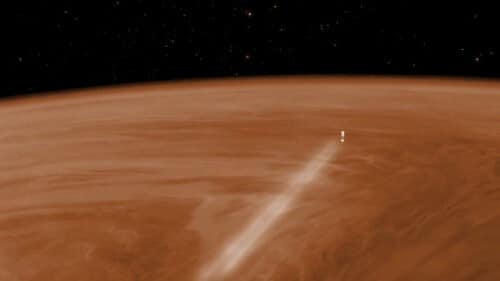The maneuver, during which the spacecraft descended twice to an altitude of about 130 km above the surface of Venus, was designed to collect data on the atmosphere and the behavior of the spacecraft in transit for the purpose of planning landing missions

Despite the danger in the maneuver, the plan to lower the Venus Express spacecraft into the thick atmosphere of Venus went through successfully. In the last month, the European Space Agency directed the old spacecraft twice to a height of 131 km above the surface of the planet, for about two minutes each time.
Now the spaceship has been raised to a higher and safer orbit. The maneuver was intended for scientific needs: during it, the spacecraft provided scientists with data about the atmosphere, and also collected engineering data that demonstrated how a spacecraft deals with contact with the atmosphere at high speed. This data will be useful for future missions that will include a landing.
"We have collected valuable data on the atmosphere of Venus in a region that is difficult to characterize in other ways," said Heikken Sodham, a scientist on the European Space Agency's Venus Express project. The findings reveal that in this altitude range the atmosphere is more diverse than previously thought, but a thorough analysis will be required to explain this variation.
The dive into Hell was difficult for the spacecraft and involved heating of more than 100 degrees Celsius. Despite this, initial reviews of the spacecraft appeared to be fine; But even in this matter further analysis will be required.
The spacecraft performed 15 ignitions of the engines in order to rise above the atmosphere, but this achievement will be only temporary. There is a very small amount of fuel left in the spacecraft, which has been orbiting the planet since 2006. In its current orbit, its lowest point is at an altitude of 460 km, but over the next few months it will gradually descend again due to the forces of gravity. Mission planners expect it to survive until about December, then fall into the atmosphere forever.
However, the scientists are comforted by the fact that the mission was successful. Among the many discoveries of Venus Express, it is worth noting the ozone layer above the planet, the water vapor scattered in the low clouds and even the discovery of a certain type of "rainbow". "The deceleration operation through the atmosphere also helped in collecting scientific data," added the European Space Agency.
"Atmospheric braking can be used to reduce the speed of a spacecraft when approaching a planet or moon with an atmosphere, so that it will be able to move to the coffee orbit, and later move from an elliptical orbit to a more circular orbit," the agency's website says. The agency also added that this maneuver saves fuel, and that "the technique can be used for future missions, and the Venus Express spacecraft experiments will help in their planning and design."

3 תגובות
What is interesting about Naga? A planet with hellish conditions and zero chance of life or future mineral mining
I wrote you a personal message on your Facebook regarding this article. Not sure you'll see, because we're not friends, but please check.